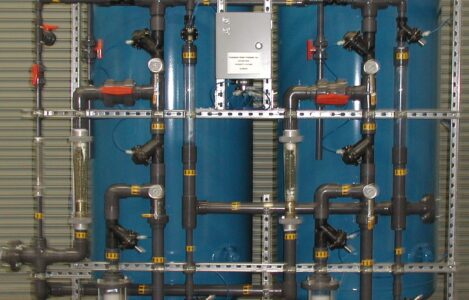

Water Softeners and Ion Exchange Systems
Get a QuoteProgressive offers a complete line of Water Softening and industrial ion exchange products to meet the needs of each individual client. Ion exchange options include softening, two-bed, mixed-bed, packed-bed (to 200 GPM/train), ion specific removal systems (i.e., nitrate, arsenic, etc.), electrodeionization (EDI), and non-regenerable units. All systems are custom design/build equipment. In every case, the customer’s requirements and preferences are considered prior to any design.
Product Information (Click to download .pdf version)
SERIES: WS – 1” Through 6” IPC 20” Through 120” Diameter (Click to download all models and sizes).
Calcium (Ca2+) and magnesium (Mg2+) ions that cause water hardness can be removed fairly easily by using an ion exchange (water softening) procedure. Softening involves the replacement of the hardness ions with a non-hardness ion. Water softeners usually use sodium (Na+) as the exchange ion. As hard water passes through a softener, the calcium and magnesium trade places with sodium ions. Sodium ions thus replace the hardness ions in the water.
The softener removes “hardness,” in the form of calcium and magnesium ions from the influent water stream.
The resin beads in the regenerated state have a high concentration of sodium ions. These sodium ions have a relatively low electrical potential compared to that of calcium and magnesium, ions. This means ions with a greater potential or charge can easily replace them. When the inlet water flows through a cation resin bed, the calcium and magnesium ions bond to the resin beads, and the beads release sodium ions in exchange.
The resins must be regenerated when water quality becomes substandard as the total amount of water softened or hardness monitoring determines. Regeneration is an ion exchange process wherein the calcium and magnesium ions on the resin beads are exchanged for sodium ions. This ion exchange is achieved by flushing the system with a brine solution that contains a high concentration of sodium ions.
Deionization (ion exchange) is a very efficient process for removing dissolved salts and minerals; mixed-bed deionizers provide higher-quality, neutral pH, and better removal of silica and CO2 than mono-bed systems.
Deionization systems can produce the quality of water required for any specific application, up to 18 megohm/cm resistivity @25C.
Standard Features
- Automated units
- 100 PSI FRP or Carbon Steel tanks
- Top mount Control Valves (up to 48”D tanks)
- Actuated PVC Ball or SST Disc Butterfly Valves (52”D tanks and up)
- Schedule 80 PVC Internal and External Piping
- Inlet/Outlet SST Pressure Gauges
Optional Features
- ASME Code Construction and stamps
- Manual Systems
- Explosion Proof Controls
- PLC Controls/HMI
- Carbon Steel, or Stainless Steel Internal/External Piping
- Service and/or Backwash Flow Sensors
- DP gauge, DP Switch or transmitter
- Hardness Monitor

